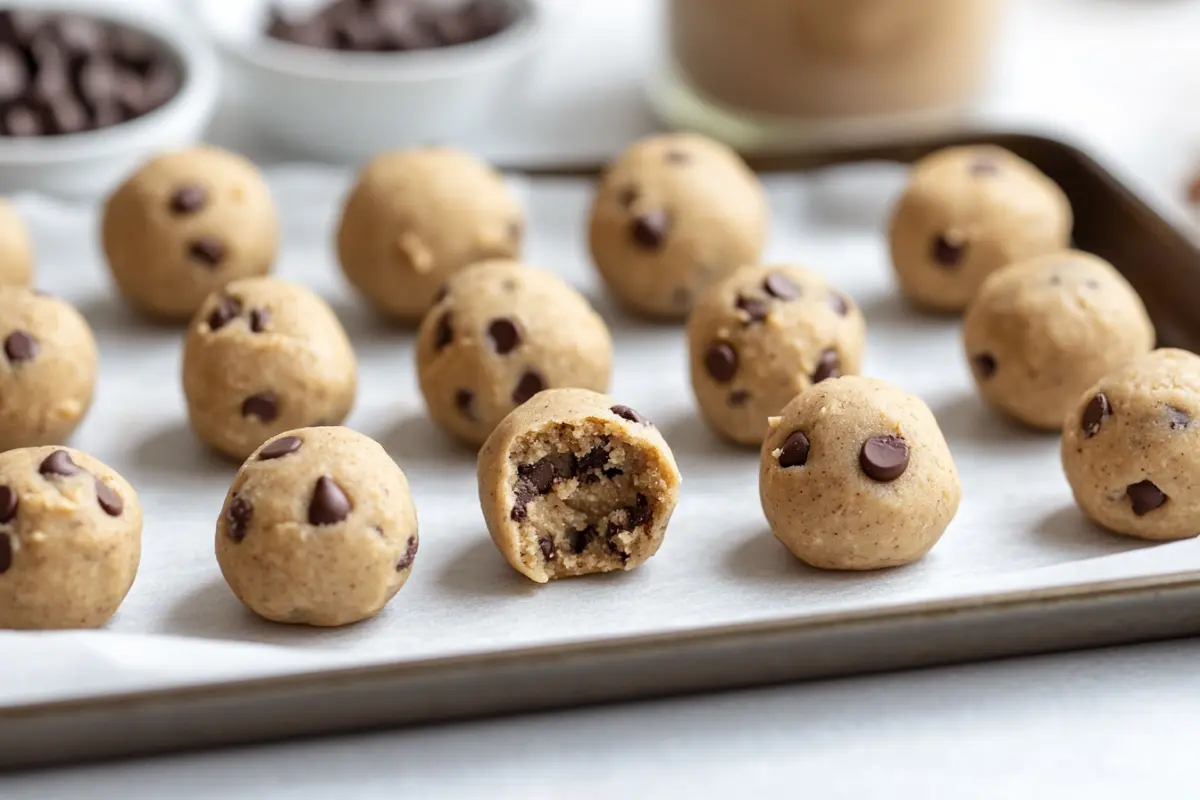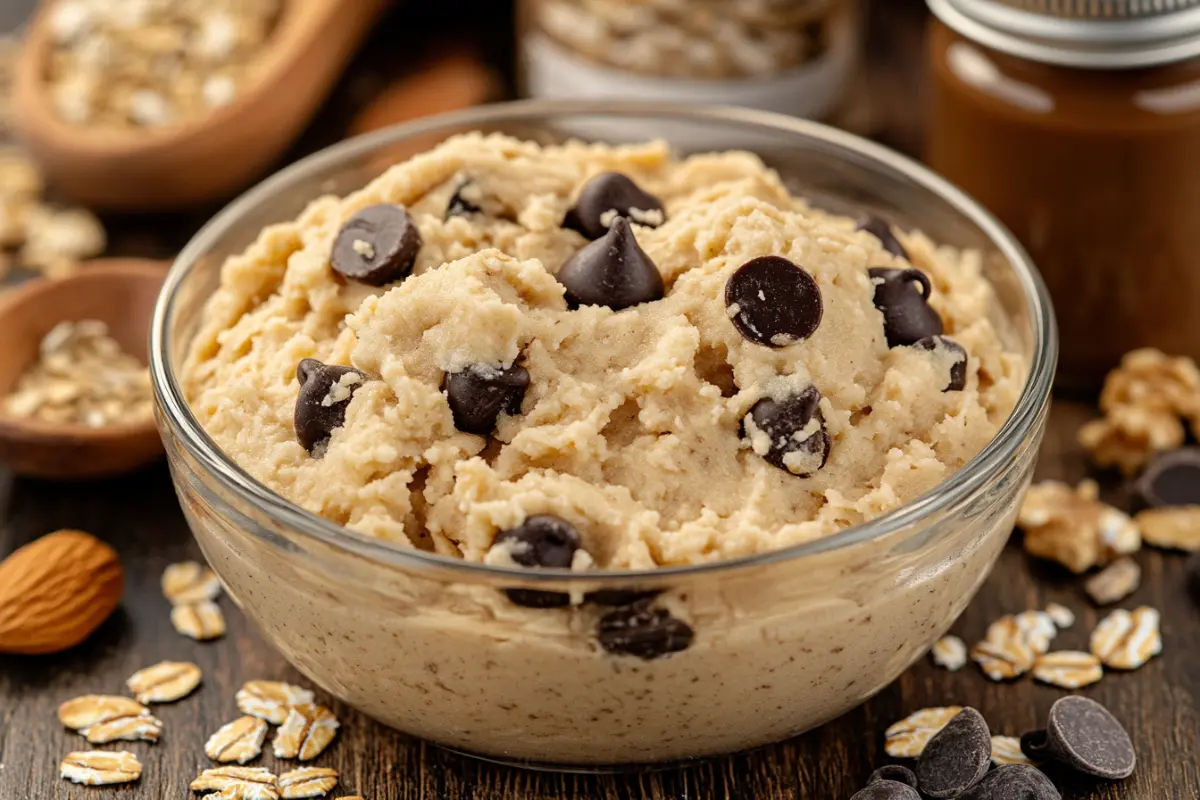Introduction
Protein cookie dough is a delicious and healthy alternative to traditional cookie dough, providing a high-protein snack that satisfies sweet cravings while supporting your nutritional goals. Whether you’re looking for a quick pre-workout boost or a guilt-free dessert, protein cookie dough is versatile enough to fit into any meal plan. With countless variations and customization options, this snack can be tailored to your taste preferences and dietary needs. In this guide, we’ll explore everything you need to know about making protein cookie dough at home, from understanding its ingredients to mastering the art of flavor variations.
What is Protein Cookie Dough?
Protein cookie dough is a high-protein alternative to regular cookie dough, made with a combination of protein powder, nut butters, and natural sweeteners. Unlike traditional cookie dough, which is often laden with sugar and unhealthy fats, protein cookie offers a more balanced macronutrient profile, making it a better choice for those looking to maintain or build muscle, manage their weight, or simply enjoy a healthier treat. Common ingredients include protein powder (whey, casein, or vegan), almond flour, oat flour, and various nut butters like peanut, almond, or cashew butter.
Essential Ingredients for Protein Cookie Dough
1. Protein Powder
The type of protein powder you choose will greatly impact the texture and flavor of your protein cookie.
- Whey Protein: Offers a creamy texture and blends well with other ingredients. It’s a popular choice for those looking to build muscle due to its high-quality amino acid profile.
- Casein Protein: Thicker than whey, providing a more dough-like consistency. It’s ideal for creating a more indulgent, dessert-like dough.
- Vegan Protein: Made from plant-based sources like pea, rice, or hemp, vegan protein powders are a great option for those following a plant-based diet. They can be slightly grittier but are perfect when paired with smooth nut butters.
2. Nut Butters
Nuts butters add richness and depth of flavor to protein cookie dough, while also contributing healthy fats.
- Peanut Butter: A classic choice, offering a robust flavor that pairs well with chocolate and vanilla-based doughs.
- Almond Butter: Milder in flavor, it’s a great option for those who prefer a more subtle taste.
- Cashew Butter: Creamy and slightly sweet, cashew butter is perfect for adding a buttery texture without overpowering other flavors.
3. Sweeteners
Natural sweeteners can enhance the flavor of protein cookie dough without adding excessive sugar.
- Maple Syrup: Adds a rich, caramel-like sweetness that complements the nutty flavors.
- Honey: Provides a floral sweetness that pairs well with vanilla and cinnamon.
- Sugar Substitutes: Stevia and monk fruit are popular sugar-free options that can sweeten the dough without affecting blood sugar levels.
4. Flours
Flours help to bind the ingredients together, creating the doughy texture we all love.
- Almond Flour: A gluten-free option that adds a slightly nutty flavor and a tender texture.
- Oat Flour: Adds a hearty, wholesome texture, making the dough more filling.
- Coconut Flour: A low-carb option that absorbs moisture well, creating a dense, chewy dough.
5. Additional Ingredients
- Chocolate Chips: A must-have for any cookie dough lover, adding bursts of sweetness throughout.
- Vanilla Extract: Enhances the overall flavor, making the dough taste more like traditional cookie dough.
- Optional Add-ins: Spices like cinnamon or nutmeg, nuts, seeds, and even dried fruits can be added to customize the flavor and texture of your dough.
Step-by-Step Guide: How to Make Basic Protein Cookie Dough

1. Preparation
Start by gathering all your ingredients and necessary kitchen tools. You’ll need:
- 1 cup of protein powder (your choice)
- 1/2 cup of almond flour or oat flour
- 1/2 cup of nut butter (peanut, almond, or cashew)
- 2-4 tablespoons of natural sweetener (maple syrup, honey, or a sugar substitute)
- 1/4 cup of milk (dairy or non-dairy) or water
- Optional: chocolate chips, vanilla extract, and other add-ins
2. Mixing the Ingredients
- Protein Powder and Flour: In a large mixing bowl, combine the protein powder and flour. This creates the base of your dough.
- Nut Butter and Sweetener: Add the nut butter and sweetener to the bowl. Mix until the ingredients are well combined. The mixture will start to resemble traditional cookie dough.
- Liquid: Slowly add the milk or water, one tablespoon at a time, until the dough reaches your desired consistency. It should be thick but pliable.
3. Optional Add-ins
- Fold in chocolate chips, nuts, or any other add-ins you prefer. This is where you can get creative and tailor the dough to your taste.
4. Final Touches
- Adjust the texture as needed by adding more liquid or protein powder. The dough should be thick enough to hold its shape but soft enough to scoop or roll.
Flavor Variations and Customization
One of the best things about protein cookie dough is how easily it can be customized. Here are a few popular variations:
1. Chocolate Chip Protein Cookie Dough
- Add 2 tablespoons of cocoa powder to the basic dough recipe for a rich chocolate flavor.
- Fold in 1/4 cup of dark chocolate chips for an extra indulgent treat.
2. Sugar Cookie Protein Dough
- Use vanilla protein powder instead of chocolate or plain.
- Omit the cocoa powder and add a touch more vanilla extract for a sweet, simple dough that tastes like classic sugar cookies.
3. Nut-Free Options
- For those with nut allergies, substitute nut butters with tahini or sunflower seed butter. These options provide a similar texture without the nuts.
4. Vegan Variations
- Use vegan protein powder and dairy-free milk in place of whey or casein and regular milk. This ensures that the dough remains plant-based without sacrificing flavor or texture.
Serving Suggestions
Protein cookie dough can be enjoyed in a variety of ways:
- As-Is: Simply scoop and enjoy the dough straight from the bowl. It’s a perfect quick snack or dessert.
- Rolled into Balls: Portion the dough into bite-sized balls for easy, on-the-go snacks. These protein bites are great for pre-workout energy or afternoon cravings.
- As a Dip: Pair the dough with fruit slices, pretzels, or crackers for a fun, interactive snack that’s both delicious and nutritious.
- Baked Options: If you prefer a traditional cookie, you can bake the dough by adding one egg and 1/2 teaspoon of baking powder. Bake at 350°F (175°C) for 10-12 minutes, or until the cookies are golden brown.
Storage and Shelf-Life
To ensure your protein cookie dough stays fresh and delicious, proper storage is key.

1. Refrigeration
- Store your protein cookie dough in an airtight container in the refrigerator. It should last for up to one week. The cold temperature helps maintain the dough’s texture and prevents spoilage.
2. Freezing
- For longer-term storage, freeze the dough. Portion it into individual servings, place them on a baking sheet lined with parchment paper, and freeze until solid. Once frozen, transfer the portions to a freezer-safe bag or container. The dough can be frozen for up to three months. When ready to eat, simply thaw a portion in the refrigerator or at room temperature.
Frequently Asked Questions (FAQs)
1. Can you bake protein cookie dough?
- Yes, you can bake protein cookie dough. Simply add one egg and 1/2 teaspoon of baking powder to the dough before baking. This will give the cookies the structure they need to hold up in the oven.
2. What’s the best protein powder to use?
- The best protein powder depends on your dietary preferences and flavor preferences. Whey is a great all-around option, casein is thicker and creamier, and vegan protein is ideal for plant-based diets.
3. How do you make protein cookie dough nut-free?
- Substitute nut butters with tahini or sunflower seed butter. These alternatives provide a similar texture without using nuts.
4. Can you make protein cookie dough without protein powder?
- Yes, but the dough won’t have the same high protein content. You can substitute protein powder with additional flour and sweeteners, but the nutritional benefits will differ.
Conclusion
Making protein cookie dough at home is a simple and rewarding way to enjoy a healthier alternative to traditional cookie dough. With endless customization options, you can create a treat that fits your taste and dietary needs perfectly. Whether you enjoy it as-is, rolled into bites, or baked into cookies, protein cookie dough is a versatile and delicious addition to your snack or dessert repertoire. Don’t hesitate to experiment with different flavors and ingredients to find your perfect combination. And if you’re looking for more healthy dessert ideas, be sure to check out our dessert category and explore protein cookies for more protein-packed treats.

